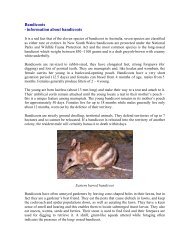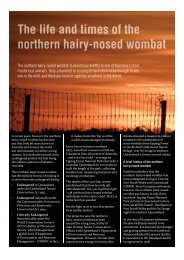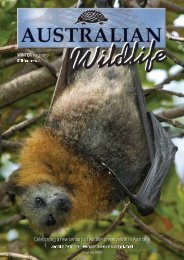Wildlife Preservation Autumn 2012.indd - Wildlife Protection Society ...
Wildlife Preservation Autumn 2012.indd - Wildlife Protection Society ...
Wildlife Preservation Autumn 2012.indd - Wildlife Protection Society ...
You also want an ePaper? Increase the reach of your titles
YUMPU automatically turns print PDFs into web optimized ePapers that Google loves.
Few conservation issues have stirred<br />
the collective consciences of the<br />
world’s nations more than the plight<br />
of cetaceans – whales, dolphins and<br />
porpoises. The dramatic turnaround<br />
from whale killing to whale watching<br />
was, ironically, as much due to economic<br />
factors resulting from the depletion<br />
of whale numbers, as to concern for<br />
the welfare and/or conservation of the<br />
species. Thanks to the persistent e orts<br />
of organisations like Greenpeace and<br />
Sea Shepherd, the needless slaughter of<br />
these ocean giants has been exposed on<br />
an international scale.<br />
Humpbacks of Hervey Bay<br />
Amy and Austin Stevens<br />
Humpback whale breaching. Photo by Austin Stevens<br />
Six months ago, we reluctantly exchanged a life of<br />
observing African wildlife in Namibia for a home on the<br />
Fraser Coast of Australia. We pined for the loss of elephants,<br />
rhinos and lions until we stepped onto a whale watch vessel<br />
in Hervey Bay and became caught up in the drama of the<br />
lives of the mighty humpback whales.<br />
This transformation is re ected in<br />
the changing role of the International<br />
Whaling Commission (IWC). The<br />
organisation was originally set up<br />
by the whaling industry in 1964 to<br />
ensure the continued viability of their<br />
business, as whale populations steadily<br />
diminished. Today the IWC has<br />
changed from harvester to protector. In<br />
1982 it declared a moratorium against<br />
large-scale commercial whaling around<br />
the globe, a move resisted only by<br />
Japan, Norway and Iceland, countries<br />
that continue their whaling under the<br />
guise of scienti c research.<br />
The humpback whale (Megaptera<br />
novaeangliae) undertakes the longest<br />
migration of any mammal on earth. It<br />
has followed regular migratory routes<br />
of approximately 5,000 kilometres<br />
from cold water feeding grounds to<br />
warm water breeding areas and back<br />
again for centuries. Their predictable,<br />
slow migration patterns lasting<br />
many months made the whales easy<br />
targets for the harpoon. In 1952,<br />
when the Australian whaling industry<br />
was established, there were an<br />
estimated 10,000 humpback whales<br />
migrating along the east coast. Ten<br />
years later, the population had been<br />
devastatingly depleted, leaving an<br />
estimated 300 to 500 humpbacks<br />
scattered thinly, and beyond<br />
commercial exploitation.<br />
In 1980 Australia opted out of the<br />
whaling industry and is now a leader<br />
in the eld of whale conservation. Not<br />
long thereafter, the Hervey Bay area,<br />
300 kilometres north of Brisbane,<br />
become recognised as one of the<br />
world’s most unique humpback whale<br />
watching locations.<br />
28 Australian <strong>Wildlife</strong> Vol 2 - <strong>Autumn</strong> 2012





